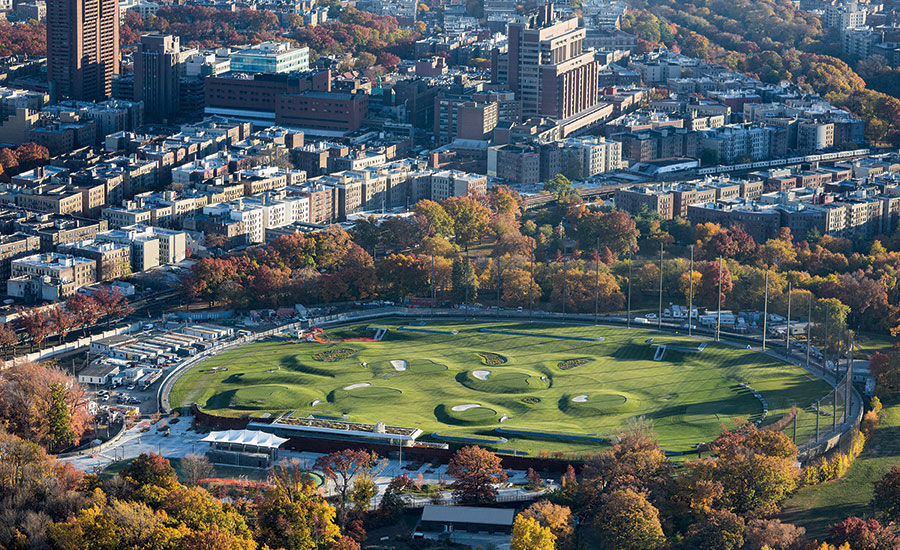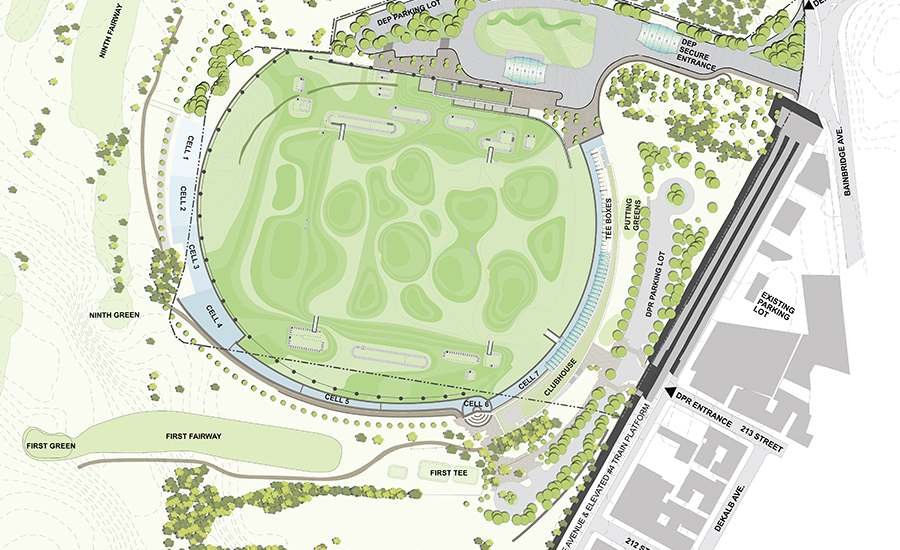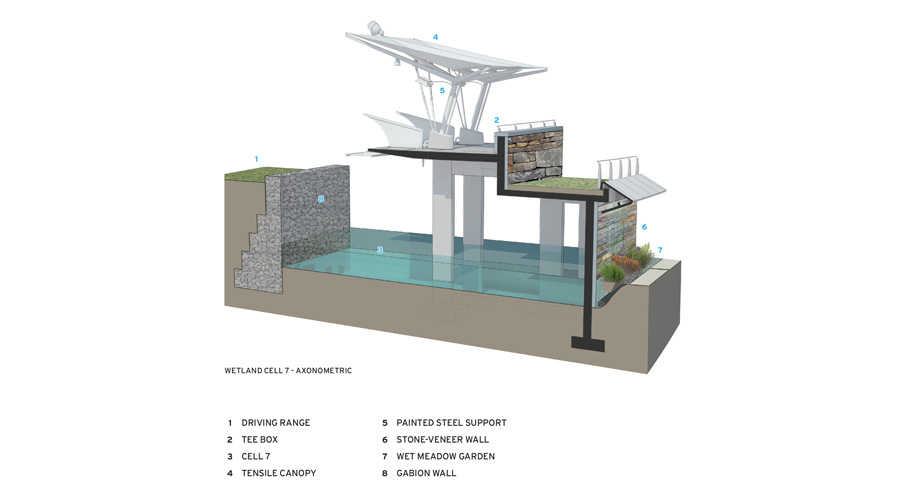Croton Water Filtration Plant
Bronx, New York

New York’s new filtration plant, which treats the water supplied from the Croton watershed, descends 100 feet into the earth, below a sculptural, nine-acre driving range.
Photo © Alex MacLean

The plant’s arrivals and receiving building seems to have grown out of one edge of the driving range, appearing to peek out from behind a ribbon of weathering steel.
Photo © PHILLIP KUEHNE/GRIMSHAW

The arrivals and receiving building is the plant’s primary staff access point.
Photo © Sara Mikhaeil/Grimshaw

Image courtesy Grimshaw

Image courtesy Grimshaw

Image courtesy Grimshaw






Architects & Firms
If you take the New York subway to the Bronx end of the No. 4 train line, make sure you turn and look west before descending from the elevated platform. From that vantage point, against the urban backdrop, you will see an oval-shaped swath of manicured turf with small sculpted hills, shallow valleys, and perfectly outlined patches of sand. This enigmatic landscape looks like burial mounds created by an ancient civilization or land art worthy of Robert Smithson.
But the mysterious terrain is neither. It is a 290-million-gallon-per-day water-filtration plant that extends 100 feet into the earth and is topped by a nine-acre golf driving range. The plant treats water coming from the Croton watershed—one of three reservoir systems supplying New York with its drinking water—while the driving range is part of a public golf course that sits on the edge of a large city park. Although the ongoing project might seem to combine an incongruous mix of uses, its disparate programs actually are complementary, points out David Burke, an associate principal at Grimshaw, the architects leading the design of the landscape and aboveground structures. “It brings together recreation and civic space and provides essential urban infrastructure,” he says.
The $3.2 billion plant, which came online last May, has a decadeslong history fraught with delays and an escalating price tag. It was deemed necessary because the increasing density and development in the areas surrounding that watershed (which stretches across three New York State counties) had gradually degraded the quality of its water. The treatment process now in place includes filtration, aeration, and exposure to ultraviolet light to remove impurities and potentially harmful micro organisms.
Although local community opposition to the plant in the Bronx was intense, the authorities decided against leaving the city limits, and eventually settled on the current location. Grimshaw won the contract to design the replacement for golf course facilities that were to be demolished, including the driving range and a clubhouse, as well as the few above-grade parts of the plant. However, the firm was not selected until 2006—well after the layout of the underground facility, by engineers Hazen & Sawyer and Metcalf & Eddy, had already been set.
But Grimshaw’s scheme, devised in collaboration with landscape architect Ken Smith and others, doesn’t look like an afterthought. The team deftly handled restrictions, such as the bearing capacity of the plant’s roof, devising a lightweight solution for the rolling topography with the help of Rana Creek, the firm behind the hilly landscape on the roof of Renzo Piano’s California Academy of Sciences in San Francisco. The driving range’s contours are created with structural polystyrene—as deep as 12 feet in some spots—with 8 to 10 inches of engineered soil on top.
The resulting three-dimensional carpet, which includes four types of turf mowed at varying heights, is circumscribed by handsome bluestone retaining walls. Some of these are veneer over concrete while others are more rustic, constructed of rocks and gabion cages.
The buildings have been designed to appear to grow out of these walls. The arrivals and receiving building (the plant’s primary staff access point), for example, seems to emerge from the northern edge of the driving range. The structure, which is off-limits to the public, has a flat roof with deep overhangs that emphasizes the ground plane; it looks as though it is peeking out from behind a ribbon of weathering steel that helps “protect and disguise” it, says Burke.
The clubhouse, which will serve the whole golf course and is slated to start construction in 2017, will rely on a similar language and materials. With a crescent-shaped footprint defined by curving bluestone walls, it will hug the driving range’s eastern edge and be covered with an accessible green roof that slopes up from the surrounding landscape. The facility will house a restaurant and pro shop and will incorporate tee boxes under a tensile fabric canopy.
Also still to come is a constructed wetland encircling the driving range. The system will consist of a series of planted cells that will naturally treat stormwater, as well as groundwater, and store it in underground tanks for irrigation. This strategy will provide multiple benefits: in addition to reducing the golf course’s demand for potable water by 40 percent, it should keep runoff out of the city’s overtaxed combined sewer system and provide habitat for birds and small mammals. It will also enhance security by providing an added physical barrier at the perimeter of the treatment plant.
This wetland, with its multiplicity of roles, is a microcosm of the multifunctional nature of the larger project and its marriage of community amenities and infrastructure. Burke predicts that, as available land diminishes and property values climb, there will be many more such seemingly improbable unions. Let’s hope these future endeavors follow the project’s lead and its creation of a dynamic, if unexpected, amalgam.
PeopleArchitect: Grimshaw Architects 637 W 27th Street New York, NY 10001 T: 646-293-3600
Personnel in architect's firm who should receive special credit: Mark Husser, AIA, Managing Partner David Burke, AIA, Associate Principal David Cook, AIA, Associate Eric Johnson, AIA, Associate Max Wolf, AIA, Architect Phillip Kuehne, LEED, Architectural Designer
Engineers: MEP: Buro Happold Structural & Civil: Ammann & Whitney
Consultants: Landscape: Ken Smith Landscape Architect Lighting: Arup Green Roof: Rana Creek Irrigation: Northern Design Sustainability: Atelier Ten Golf Course Design Consultant: Stephen Kay/Doug Smith Golf Course Design
General contractor: Skanska Civil
Client: New York City Department of Environmental Protection
Size: 1.7 million square feet (plant, above-grade structures, landscape)
Cost: $3.2 billion (plant, above-grade structures, landscape)
Completion Date: Ongoing |
ProductsStructural system Concrete (buildings), steel (canopy beams, net poles) Weathering steel wall: Mariani Metals
Exterior cladding Masonry: New York Quarries (fabricator), Berardi Stone Setting (installer) Metal Panels: Mariani Metals (fabricator) Metal/glass curtain wall: Norshield (fabricator) Precast concrete: Coreslab Structures (exterior precast panel & canopy column fabricator)
Roofing Built-up roofing: Hydrotech (WP)
Windows Metal frame: Kawneer
Glazing Glass: Viracon, Cristacurva
Hardware Locksets: Dorma Closers: Dorma Pulls: Blumcraft, Dorma
Interior finishes Acoustical ceilings: Armstrong Suspension grid: Armstrong metal ceiling Cabinetwork and custom woodwork: GW Manufacturing Paints and stains: Sherwin Williams Paneling: Mariani Metals (weathering steel wall panels) Plastic laminate: Johnsonite (desk & cabinetry) Special surfacing: Ice Stone (bathroom counter) Floor and wall tile: Stone Source (bathroom), Crossville (bathroom) Resilient flooring: Johnsonite Bluestone flooring: New York Quarries
Lighting Interior ambient lighting: Elliptipar Downlights: Se’lux, Lucifer, Lightolier Exterior: Bega, B-K Lighting, Kim Lighting
Conveyance Elevators/escalators: Heights Elevator Corp. Accessibility provision: Advance Lifts
|










